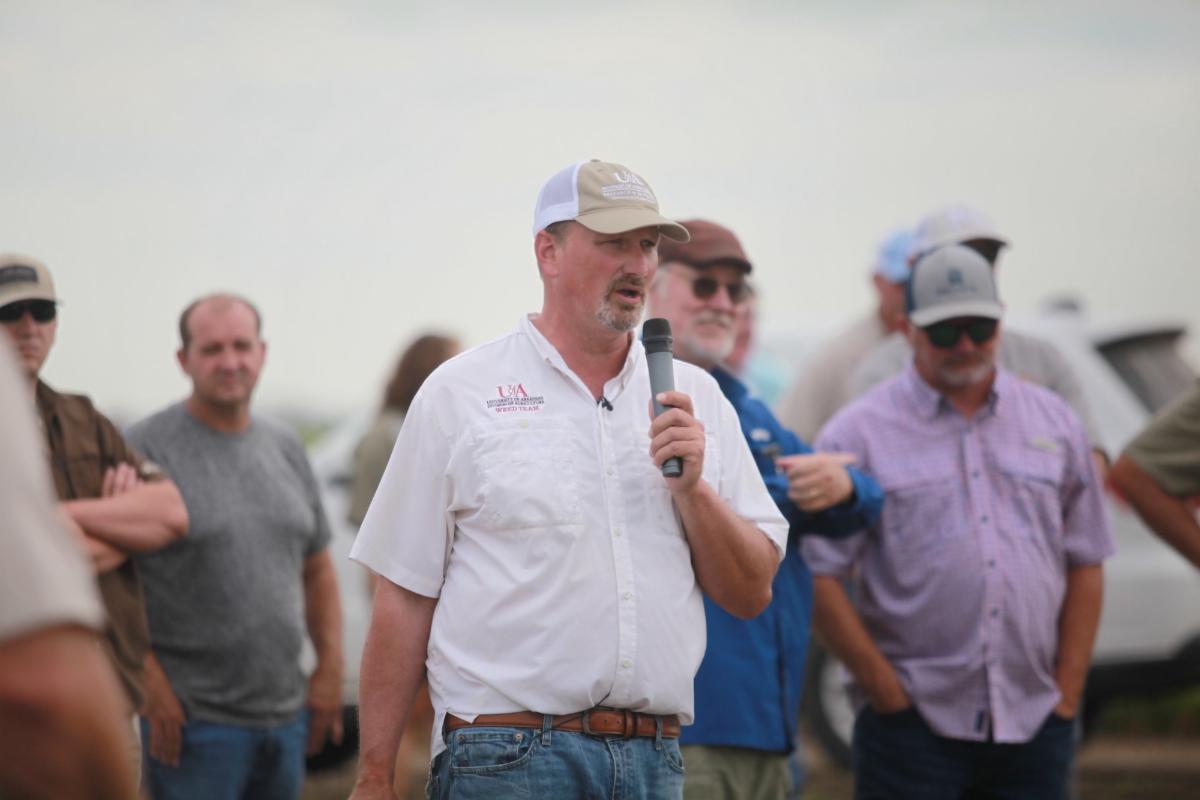March 2025 Arkansas Ag Research Report
IN THIS ISSUE:
- Find out who was honored as a 2025 Fellow of the American Association for the Advancement of Science.
- See how John Deere’s See & Spray™ worked in a three-year field trial.
- Rising egg prices have put a $1.41 billion burden on consumers.
- Poultry scientists offer revelations about slow-growth broilers.
- Mahfuzur Rahman was awarded this year’s Andersons Early-in-Career Award.
Marty Matlock, professor of biological and agricultural engineering, has been named a 2025 Fellow of the American Association for the Advancement of Science, or AAAS. This honor recognizes his contributions to agricultural sustainability standards and expanding Indigenous STEM participation.
Becoming a Fellow of the association is a lifetime honor, a tradition dating back to 1874, according to AAAS. Matlock joins an elite group of scientists and engineers who are celebrated for advancing science and its application to address global challenges.
Rahman honored with Andersons Early-in-Career Award
Mahfuzur Rahman, a food scientist and grain processing engineer with the Arkansas Agricultural Experiment Station, is this year’s recipient of the Andersons Early-in-Career Award.
The Andersons Early-in-Career award was presented by NC-213: The U.S. Quality Grains Research Consortium on Feb. 20 in Olathe, Kansas. The award recognizes individuals early in their careers whose work has “significantly contributed to improvements in science, innovation, technology implementation, policy formation, and/or education related to quality of cereals and oilseeds from processing to consumption, and who show outstanding promise of continuing those contributions into the future.”
“It is an honor to receive this Early-in-Career Award, and it will further motivate me to continue my research on cereals and oilseeds,” Rahman said.
Research Spotlights
Growth rates of broilers contribute to behavior differences, shed light on welfare impacts
As poultry companies weigh cost and efficiency with higher animal welfare standards, research comparing conventional and slow-growing broiler breeds showed that the slow-growing chickens displayed behaviors more closely associated with positive welfare.
Rosie Whittle, poultry science postdoctoral researcher with the Center for Food Animal Wellbeing and the Dale Bumpers College of Agricultural, Food and Life Sciences at the University of Arkansas, recently joined Shawna Weimer, assistant professor of poultry science and director of the Center for Food Animal Wellbeing, in a study that offered revelations on the physiological differences in the two different breeds of broilers.
Their study was published in Poultry Science, an official journal of the Poultry Science Association. Observations included that a larger percentage of slow-growing broilers were observed standing, walking, and preening, which are signs of positive animal welfare. The effects of stocking density were minimal, so the number of birds in an area did not have a significant impact on broiler behavior.
Precision agriculture research measures effectiveness of See & Spray technology
A three-year field trial in Arkansas soybeans showed proper use of John Deere’s See & Spray™ spot-spray technology can cut post-emergence herbicide use by half and could save millions of dollars in expenses.
Jason Norsworthy, Distinguished Professor of weed science for the Arkansas Agricultural Experiment Station, has evaluated the system in test plots at the Northeast Research and Extension Center in Keiser since 2017 as part of his broader research on weed management in Arkansas crops and the growing resistance of agricultural weeds to existing herbicide chemistries.
Results of the field trial indicate that the system can offer a short return on investment at the lowest sensitivity setting; however, operating at that setting increased pigweed population by 280 percent each year. At the highest sensitivity setting, targeted spray applications were generally comparable to the standard broadcast application but allowed for a 43-59 percent reduction in herbicide use compared to broadcast applications.
Economists tackle estimating consumer effects following the loss of billions of birds and eggs due to avian influenza
Fewer and more expensive eggs in 2024 put an estimated $1.41 billion burden on consumers in 2024, according to study by a trio of researchers examining the impact of highly pathogenic avian influenza — HPAI — on the economy.
The study, “The Economic Impact of HPAI on U.S. Egg Consumers: Estimating a $1.41 Billion Loss in Consumer Surplus,” was published by the Fryar Price Risk Management Center.
James Mitchell, assistant professor and extension economist, was the lead author of the study, which was written with Jada Thompson, associate professor, and Trey Malone, formerly a faculty member with the University of Arkansas System Division of Agriculture, but now at Purdue University.
Watch
Ashley Dowling – Tiny Creatures, Big Impact
If Ashley Dowling hopes to accomplish one thing as an educator, it would be to rekindle the appreciation for insects your 3-year-old self once had. Dowling’s research focuses on the mite world, which includes ticks and chiggers among many others. To Dowling, the best scientific discoveries come from careful observation and an openness to ask new questions.
Hot off the Press
2024 Arkansas Soybean Performance Tests
The 2024 Arkansas Soybean Performance Tests are conducted each year to aid the Arkansas Cooperative Extension Service in formulating variety recommendations for soybean producers and to provide information to companies developing varieties and/or marketing seed within the state. This year’s publication includes data from six locations throughout Arkansas.











